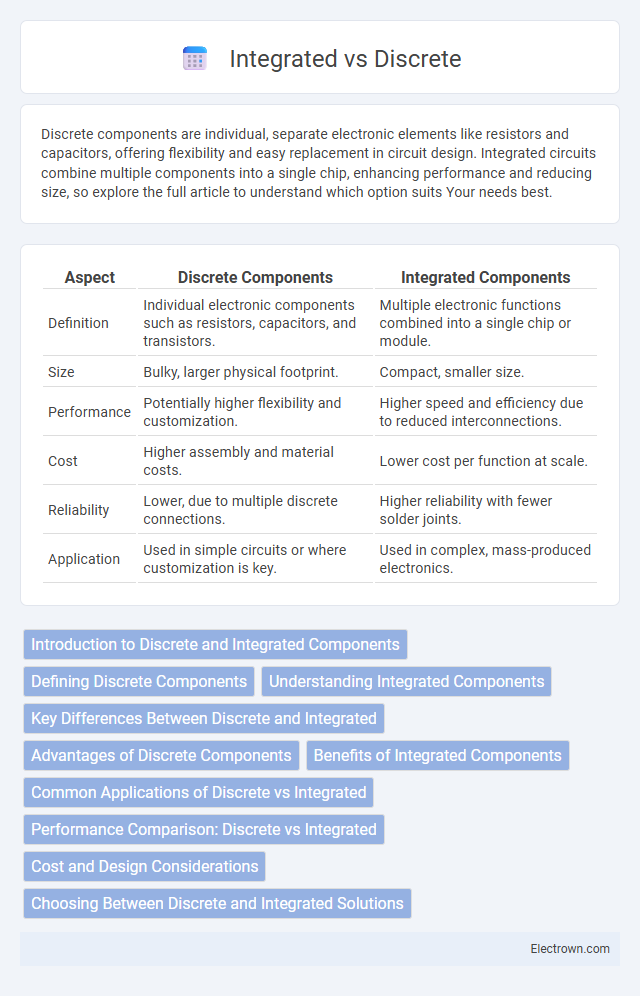Discrete components are individual, separate electronic elements like resistors and capacitors, offering flexibility and easy replacement in circuit design. Integrated circuits combine multiple components into a single chip, enhancing performance and reducing size, so explore the full article to understand which option suits Your needs best.
Table of Comparison
| Aspect | Discrete Components | Integrated Components |
|---|---|---|
| Definition | Individual electronic components such as resistors, capacitors, and transistors. | Multiple electronic functions combined into a single chip or module. |
| Size | Bulky, larger physical footprint. | Compact, smaller size. |
| Performance | Potentially higher flexibility and customization. | Higher speed and efficiency due to reduced interconnections. |
| Cost | Higher assembly and material costs. | Lower cost per function at scale. |
| Reliability | Lower, due to multiple discrete connections. | Higher reliability with fewer solder joints. |
| Application | Used in simple circuits or where customization is key. | Used in complex, mass-produced electronics. |
Introduction to Discrete and Integrated Components
Discrete components, such as resistors, capacitors, and inductors, are individual electronic devices that perform specific functions within a circuit, offering flexibility and ease of replacement. Integrated components combine multiple semiconductor devices into a single chip, enhancing performance, reducing size, and lowering manufacturing costs. Understanding the distinct roles and applications of discrete versus integrated components is essential for optimizing circuit design and functionality.
Defining Discrete Components
Discrete components are individual electronic parts with a single function, such as resistors, capacitors, and transistors, designed to perform specific tasks within a circuit. Unlike integrated components that combine multiple functions on a single chip, discrete components offer greater flexibility and easier troubleshooting in complex electronics. Understanding how these standalone parts operate enables you to optimize circuit design and tailor performance to precise requirements.
Understanding Integrated Components
Integrated components combine multiple discrete functions into a single package, improving system efficiency and reducing size and cost. These components enhance performance by minimizing interconnect losses and simplifying circuit design processes. Understanding integrated components is essential for optimizing electronic device functionality and achieving compact, reliable assemblies.
Key Differences Between Discrete and Integrated
Discrete components are individual electronic parts like resistors, capacitors, and transistors, each performing a specific function separately, while integrated components combine multiple functions into a single chip or module. Key differences include size, with discrete components being larger and more suitable for customization, whereas integrated circuits (ICs) offer compactness and improved reliability due to fewer interconnections. Your choice between discrete and integrated solutions depends on design complexity, cost constraints, and performance requirements.
Advantages of Discrete Components
Discrete components offer superior customization and flexibility, allowing engineers to select individual parts tailored to specific circuit requirements. They provide easier troubleshooting and repair since each component can be tested and replaced independently. Enhanced thermal management is possible with discrete components, improving reliability in high-power applications.
Benefits of Integrated Components
Integrated components reduce the physical space needed in electronic devices, leading to more compact and lightweight designs. These components improve system reliability by minimizing interconnections and potential points of failure. Your devices benefit from lower manufacturing costs and enhanced performance due to optimized communication between integrated elements.
Common Applications of Discrete vs Integrated
Discrete components are commonly used in applications requiring high power, precise control, and easy replacement, such as in power supplies, audio amplifiers, and RF circuits. Integrated circuits dominate consumer electronics, computing devices, and telecommunications due to their compact size, cost efficiency, and complex functionality integration. Industrial automation and automotive systems often combine both discrete and integrated components to optimize performance and reliability.
Performance Comparison: Discrete vs Integrated
Discrete graphics cards deliver superior performance compared to integrated graphics by utilizing dedicated video memory and specialized hardware, offering higher frame rates and better handling of demanding applications such as gaming and 3D rendering. Integrated graphics rely on shared system memory, which limits bandwidth and processing power, resulting in lower performance for intensive graphical tasks. Benchmarks consistently show discrete GPUs outperforming integrated solutions in metrics like frames per second, rendering times, and support for advanced graphical features.
Cost and Design Considerations
Discrete components often lead to higher manufacturing costs due to increased assembly complexity and larger PCB real estate, impacting overall design budgets. Integrated solutions reduce component count and board space, enhancing reliability and lowering production expenses through simplified assembly processes. Your choice between discrete and integrated designs should balance cost constraints with performance and flexibility requirements.
Choosing Between Discrete and Integrated Solutions
Choosing between discrete and integrated solutions depends on factors such as performance requirements, cost constraints, and design complexity. Discrete components offer higher customization and better heat dissipation, making them suitable for high-performance applications, while integrated solutions provide compactness and lower power consumption, ideal for space-sensitive or cost-sensitive projects. Evaluating system specifications and long-term maintenance needs ensures optimal selection for the intended application.
Discrete vs integrated Infographic

 electrown.com
electrown.com